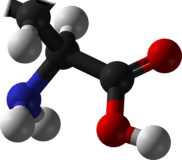Valine
| |||
| Names | |||
|---|---|---|---|
| IUPAC name
Valine | |||
| Other names
2-amino-3-methylbutanoic acid | |||
| Identifiers | |||
| 516-06-3 72-18-4 (L-isomer) 640-68-6 (D-isomer) | |||
| ChEBI | CHEBI:57762 | ||
| ChEMBL | ChEMBL43068 | ||
| ChemSpider | 6050 | ||
| DrugBank | DB00161 | ||
| EC-number | 208-220-0 | ||
| |||
| Jmol-3D images | Image | ||
| KEGG | D00039 | ||
| PubChem | 1182 | ||
| |||
| UNII | 4CA13A832H | ||
| Properties[1] | |||
| Molecular formula |
C5H11NO2 | ||
| Molar mass | 117.15 g·mol−1 | ||
| Density | 1.316 g/cm3 | ||
| Melting point | 298 °C (568 °F; 571 K) (decomposition) | ||
| soluble | |||
| Acidity (pKa) | 2.32 (carboxyl), 9.62 (amino)[2] | ||
| Supplementary data page | |||
| Refractive index (n), Dielectric constant (εr), etc. | |||
| Thermodynamic data |
Phase behaviour solid–liquid–gas | ||
| UV, IR, NMR, MS | |||
| Except where noted otherwise, data is given for materials in their standard state (at 25 °C (77 °F), 100 kPa) | |||
| | |||
| Infobox references | |||
Valine (abbreviated as Val or V)[3] is an α-amino acid with the chemical formula HO2CCH(NH2)CH(CH3)2. L-Valine is one of 20 proteinogenic amino acids. Its codons are GUU, GUC, GUA, and GUG. This essential amino acid is classified as nonpolar. Human dietary sources are any proteinaceous foods such as meats, dairy products, soy products, beans and legumes.
Along with leucine and isoleucine, valine is a branched-chain amino acid. It is named after the plant valerian. In sickle-cell disease, valine substitutes for the hydrophilic amino acid glutamic acid in hemoglobin. Because valine is hydrophobic, the hemoglobin is prone to abnormal aggregation.
Nomenclature
According to IUPAC, carbon atoms forming valine are numbered sequentially starting from 1 denoting the carboxyl carbon, whereas 4 and 4' denote the two terminal methyl carbons.[4]
Biosynthesis
Valine is an essential amino acid, hence it must be ingested, usually as a component of proteins. It is synthesized in plants via several steps starting from pyruvic acid. The initial part of the pathway also leads to leucine. The intermediate α-ketoisovalerate undergoes reductive amination with glutamate. Enzymes involved in this biosynthesis include:[5]
- Acetolactate synthase (also known as acetohydroxy acid synthase)
- Acetohydroxy acid isomeroreductase
- Dihydroxyacid dehydratase
- Valine aminotransferase
Synthesis
Racemic valine can be synthesized by bromination of isovaleric acid followed by amination of the α-bromo derivative[6]
- HO2CCH2CH(CH3)2 + Br2 → HO2CCHBrCH(CH3)2 + HBr
- HO2CCHBrCH(CH3)2 + 2 NH3 → HO2CCH(NH2)CH(CH3)2 + NH4Br
References
- ↑ Weast, Robert C., ed. (1981). CRC Handbook of Chemistry and Physics (62nd ed.). Boca Raton, FL: CRC Press. p. C-569. ISBN 0-8493-0462-8.
- ↑ Dawson, R.M.C., et al., Data for Biochemical Research, Oxford, Clarendon Press, 1959.
- ↑ "Nomenclature and symbolism for amino acids and peptides (IUPAC-IUB Recommendations 1983)", Pure Appl. Chem. 56 (5), 1984: 595–624, doi:10.1351/pac198456050595.
- ↑ Jones, J. H., ed. (1985). Amino Acids, Peptides and Proteins. Specialist Periodical Reports 16. London: Royal Society of Chemistry. p. 389. ISBN 978-0-85186-144-9.
- ↑ Lehninger, Albert L.; Nelson, David L.; Cox, Michael M. (2000), Principles of Biochemistry (3rd ed.), New York: W. H. Freeman, ISBN 1-57259-153-6.
- ↑ Marvel, C. S. (1940). "dl-Valine". Org. Synth. 20: 106.; Coll. Vol. 3, p. 848.
See also
External links
| |||||||||||||||||||||||||||||||||||||||||||||||||||||||||||||
| ||||||||||||||||||||||||||||||||||||||||||||||||||||||||||||||||||||||||||||||||||||||||||||||||||||||||||||||||||||||||


